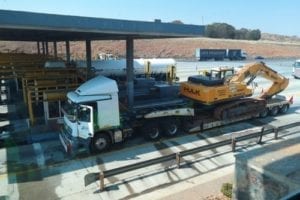Trouble-free abnormal loads transport boils down to effective planning. Tristan Wiggill learns more from Andrew Nicholson.
What are the risks associated with transporting abnormal loads by road? AN: A load can be classified abnormal based on its height, width, length and/or weight. Transporting abnormal loads by road is slow going, with the greatest risk posed to other road users. Impatience, lack of understanding and low levels of awareness are the main causes of incidents on the road. There is not much room to manoeuvre and even less room for error. Drivers are required to ensure the safety of their load, other road users and themselves. How can the risks be mitigated? The most effective way to mitigate risk is through continuous and meticulous training. By ensuring that you have an exceptionally trained team of both truck and escort drivers, you lower the risk of incidents. Increasing the defensive driving skill of drivers also increases their level of awareness and anticipation, which should lower exposure levels to 3rd party incidents. Advanced fleet management systems that can perform a range of monitoring functions – remotely and in real time – further reduces risk. It is important to prioritise and adequately resource route planning, ensuring that loads travel the safest routes to their destinations. Failing to plan the route diligently causes delays and congestion, bridge crossing and access challenges and other traffic flow issues through and around towns and cities. What does this planning entail? Detailed route surveys and discussions and bookings with traffic officials, should police escorts be required. Adequate briefing of drivers is needed to ensure a comprehensive understanding of the route and the on-road risks associated with it. It all boils down to advanced planning before loading. What technologies are making abnormal load transport easier and safer? Monitoring and management systems (in our case MAX, Drive Cam, and Drive Smart) generate and maintain professional driving cultures. Management and drivers integrate these tools into every aspect of their working lives to maximise the safety benefits for everyone. What is the most cost-effective way to transport abnormal loads within South Africa? Most certainly by road granted you select the correct partner who looks at the whole journey and ensures safe, efficient and effective transport. Hold-ups and on-road issues can become hugely costly very quickly. Sometimes transporters offering the cheapest rates end up costing more, due to the many hidden costs on the route. What is the biggest mistake companies make when transporting abnormal loads?Incorrect truck configurations and truck and trailers that run overly large loads. These practices pose extreme safety risks, damage road surfaces, slow traffic and inevitably cost the taxpayer money.
How is permanent structures and infrastructure dealt with? Planning, planning and more planning. These obstacles are identified and are highlighted as high-risk areas during pre-load route surveys. Drivers are briefed prior to being dispatched, during which these areas are clearly highlighted. Once encountered on the route they are carefully scouted before further progress commences. What steps are taken to limit damage to vehicles and road infrastructure? Planned job observations are conducted during the loading, lashing and transporting process. Technology is also used to ensure that we place the correct load on the correct vehicle configuration. In so doing, we ensure that all loads meet the legal requirements with regards to axle mass and load distribution. Andrew Nicholson is managing director specialised, at Barloworld Transport
Andrew Nicholson is managing director specialised, at Barloworld Transport








